For just over four decades, from 1923 to 1964, two of Major League Baseball’s most iconic stadiums sat across from one another on either side of the Harlem River: Yankee Stadium – located at East 161st Street & River Avenue, in the Bronx, New York, and the Polo Grounds (III and IV), located at 157th Street and 8th Avenue, in Harlem, New York.

Yankee Stadium was home to the New York Yankees from its opening in 1923, until it’s demolition after the 2008 season. The Polo Grounds was home to the New York Giants (and the New York Yankees from 1913 to 1922) from 1891 to 1957, and the New York Mets from 1962 to 1963. It was demolished in June 1964.

Circle Line Sightseeing Tours
Circle Line Sightseeing Tours began its trips around Manhattan Island in 1945. In 2021, it is celebrating its 75th year.

Circle Line offers seasonal departures out of “Pier 83,” located at 83 North River Piers, W 42nd St, New York, NY.

One of the cruises circles Manhattan, heading south on the Hudson River with Manhattan to the East, and then north on the Harlem River with Manhattan to the West.

Yankee Stadium and the Polo Grounds were popular sites on the Circle Line cruise. For almost two decades, from 1945 until 1964, sightseers taking the three hour tour around Manhattan could see both iconic ballparks as they cruised the Harlem River portion of the excursion.

After demolition of the Polo Grounds in 1964, sightseers could still view “old” Yankee Stadium from the Harlem River, and witness the changes brought on by the stadium’s major renovation in 1973 and 1974.

These photographs are magical, not only for the images offered of the two ballparks, but because they capture the moment in time when the sightseer decided to snap a photograph of the ballpark. Each photograph is unique, offering a different vantage point of the stadiums’ every-changing appearances. These vintage 35mm slides and snapshots help us relive those days when a Circle Line tour passed by these classic ballparks, offering witness to how they changed over the years. The majority of images featured in this blog are 35mm slides, with just a few being snapshot photos, all by now-unknown amateur photographers, taken while traveling the Harlem River.
The Polo Grounds
The Polo Grounds that appears in these photographs is the fourth incarnation of the ballpark. Polo Grounds (IV) was constructed in 1911 after a fire destroyed Polo Grounds (III). The photograph below shows the Polo Grounds, prior to demolition of the 9th Street Elevated Line (which occurred in the early 1940s). This photograph was taken from the vantage point of the Harlem River, but predates Circle Line sightseeing cruises.

The following two photographs were taken in June 1950 by different photographers. The first, which is one side of a stereo slide, depicts the Public Housing Project under construction, which replaced the railroad yard that once was adjacent to the Polo Grounds.
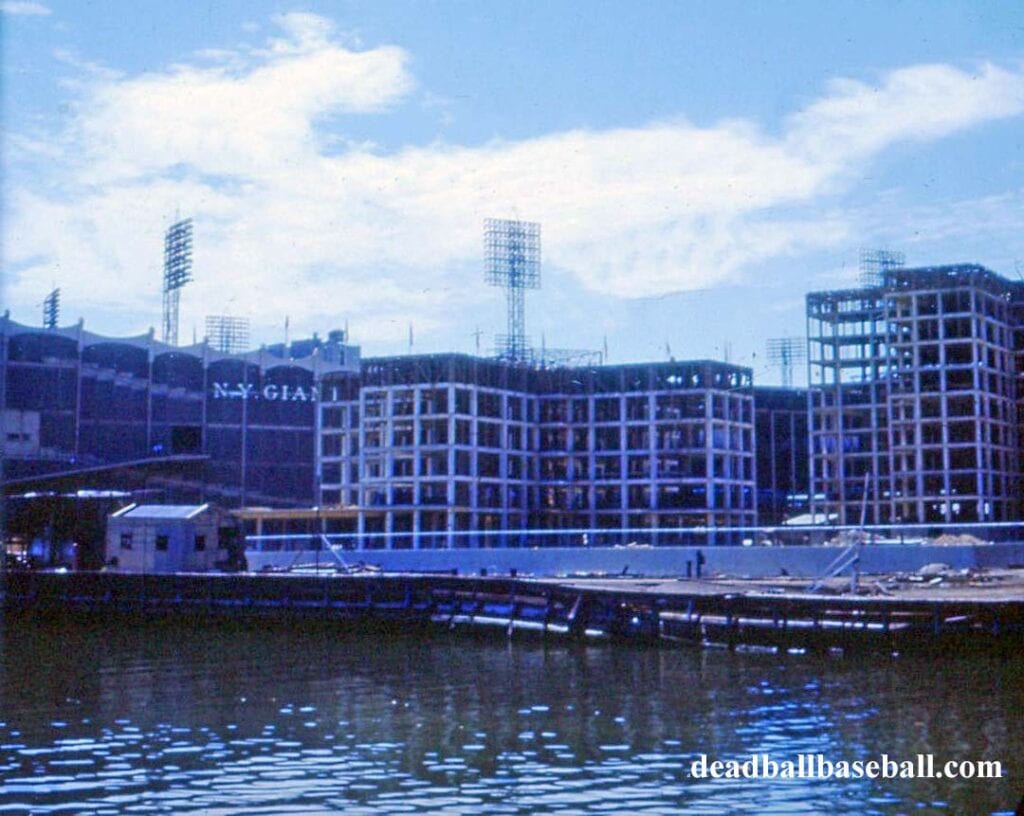
The second photograph, a 35mm slide, shows the Polo Grounds in 1950, as it appeared fronting 7th Avenue (now Adam Clayton Powell, Jr., Blvd.). Note the brown brick façade and the stand-alone NY GIANTS lettering that appears above the entrance to the ballpark.

The photograph below capture the vibrant orange NY GIANTS lettering above the entrance to the ballpark.
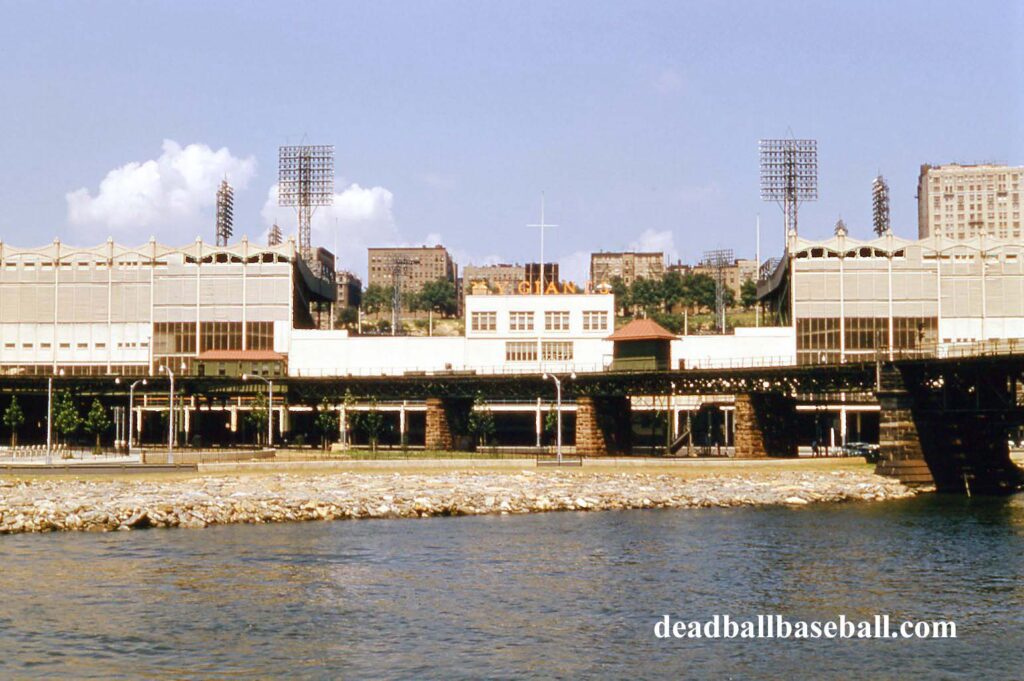
During the mid-1950s, the Giants painted white the front entrance to the ballpark, as is evident in the following two photographs.


The Giants played their final home game at the Polo Grounds on September 29, 1957. The photograph below was taken during the Giants’ final season there.

The Giants departed New York at the end of the 1957 season, moving to San Francisco, California, where they played the 1958 and 1959 seasons at Seals Stadium. In 1960, the Giants moved to their brand new ballpark located on Candlestick Point, in San Francisco. The Polo Grounds sat empty during the next three baseball seasons. The photograph below was taken during the 1960 season. During those three years, from the vantage point of the Harlem River, the ballpark appeared ready as ever to host a game.
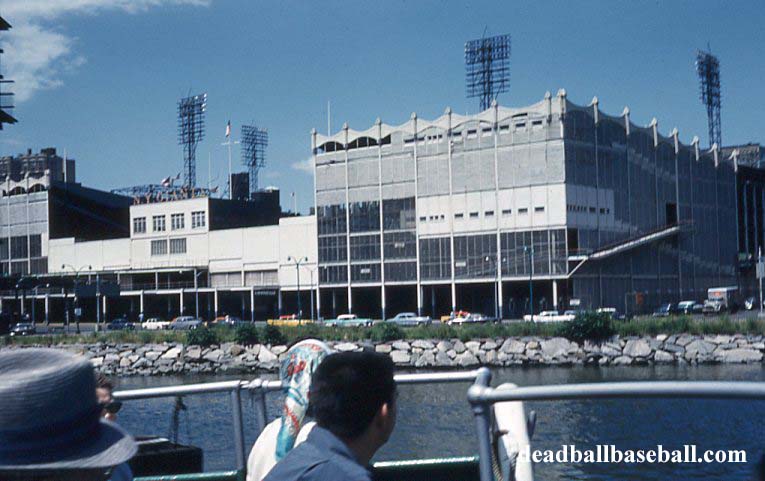
Major League Baseball returned to the Polo Grounds in 1962 with the arrival of the National League New York Mets. Gone were the orange NY GIANTS lettering above the entrance to the ballpark. The front façade was repainted as well, with a decidedly 1960’s flair of orange and blue, emulating the colors of the new home team.


After the 1963 season, the Mets departed the Polo Grounds for Shea Stadium. In the 1964 photograph below, a crane used during demolition of the Polo Grounds is visible hovering over the ballpark. Demolition began in April 1964 and was completed by mid-summer. Demolition of the light stanchions was complete by the time this image was captured.
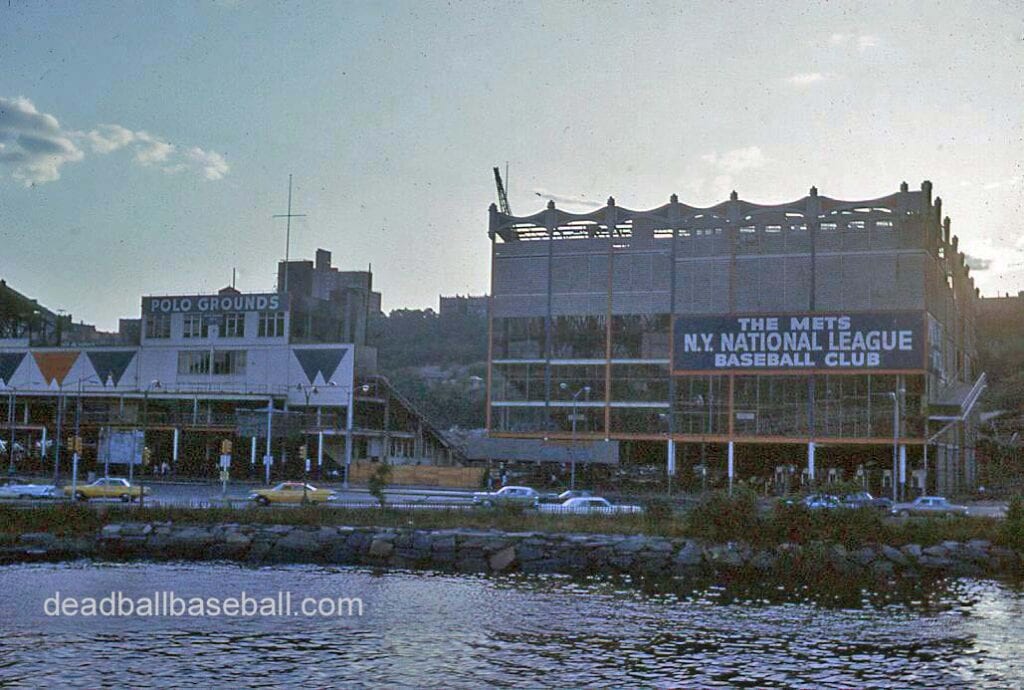
In this final photograph of the Polo Grounds, only the front portion of the ballpark remains standing. The rubble of the once-vast grandstand is visible just beyond what remains of the front façade.

Yankee Stadium
In 1923, Yankee Stadium began its 85-year tenure on the banks of the Harlem River. The snapshot below was taken in 1928, just five years after Yankee Stadium opened, and almost two decades before Circle Line began its operations. Note that the view of the ballpark from the Harlem River is relatively unobstructed, a marked difference from the later photographs of Yankee Stadium that appear below.

The photograph below was captured in 1950, just four years after light stanchions were added to the roof of Yankee Stadium. The first night game was played at the stadium on May 28, 1946.

Other than the addition of light stanchions to the ballpark, the view of Yankee Stadium, as seen from Circle Line cruise ships, did not change much during the stadium’s first 30 years.
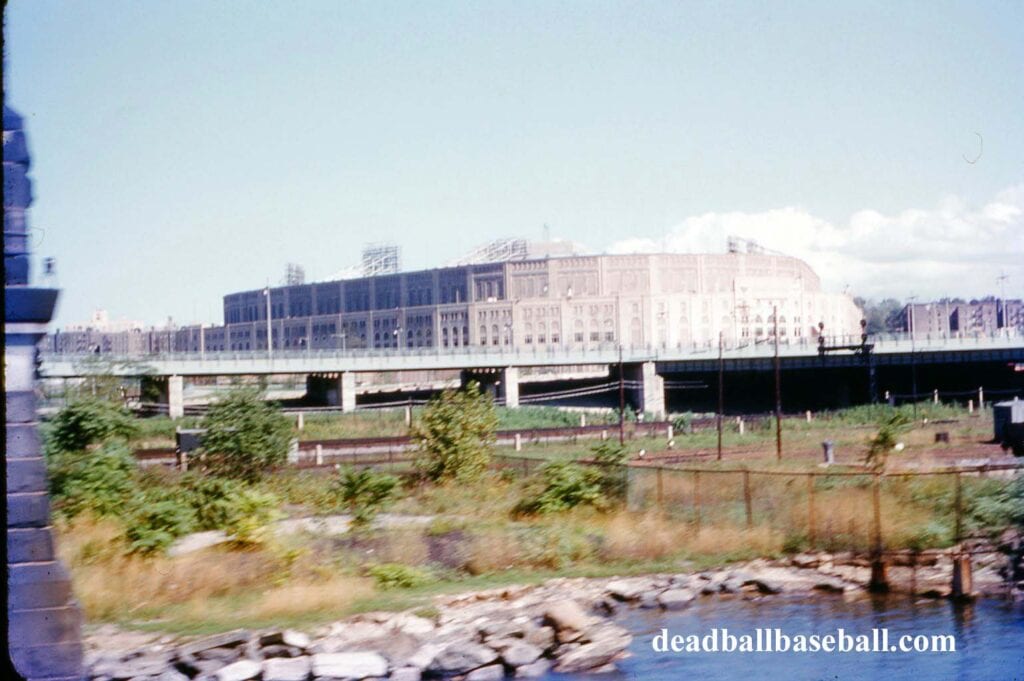
By the 1950s, photographs of Yankee Stadium taken from the Harlem River featured views of the Major Deegan Expressway, as well as the train tracks that ran alongside the highway.

After the end of the 1955 season, Yankee Stadium underwent a renovation which included the addition of a Longines electric clock above Gate 4 and large YANKEE STADIUM lettering in white, placed on a black background.

A typical Circle Line cruise on the Harlem River, with sightseers gazing at Yankee Stadium

The vantage point from which the photograph below was taken captures a significant portion of the Bronx County Courthouse, which also was visible from inside the ballpark, beyond the center field fence.

The Longines clock above Gate 4 was readily-visible from the Major Deegan Expressway, as well as the Harlem River.

Depending upon the vantage point of where the photograph of the stadium was taken, the building that housed the Merchants Food Distributors, Inc., provided yet another distinctive landmark along the shores of the Harlem River.

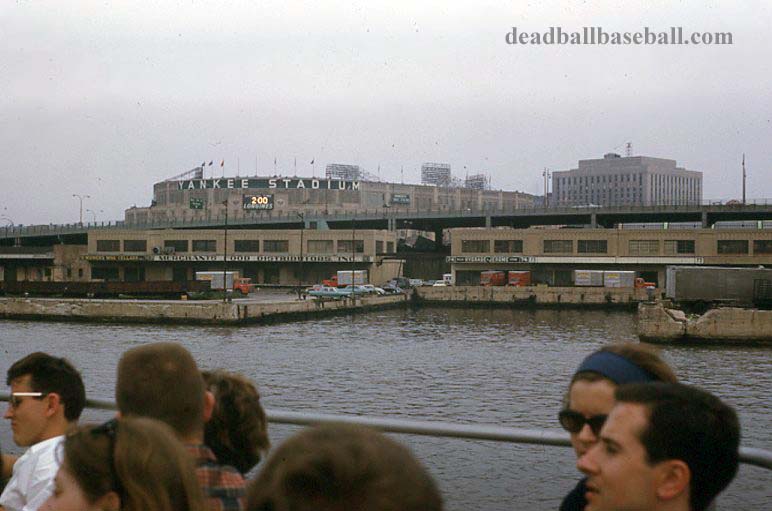
The following two photographs, taken in June and September 1966, capture the last year of the distinctive YANKEE STADIUM white lettering that appeared above Gate 4.


At the end of the 1966 season, the then-current owners of the ballpark, Rice University, white washed the stadium’s front façade and installed black lettering in its place. Two lines of electronic text were added just below the Longines clock as well

In 1973, Yankee Stadium underwent a major renovation, which required the Yankees to play their home games at Shea Stadium during the 1974 and 1975 season.

The façade was retained, but a new upper deck replaced the old stadium’s roof, and the seating bowl was demolished and completely refurbished.

The Yankees moved into the newly-renovated stadium in 1976, and played there another 33 years. After the 2008 season, the Yankees departed the stadium for a new ballpark across E 161st Street. The old stadium was demolished in the Spring of 2009.
Photographs (Slides) of Both Stadiums Taken the Same Day
The following two pairs of photographs are companion photographs. The first set was taken on the same day, circa 1955.


The second pair of photographs, also taken on the same day, are circa 1956, and were captured just after completion of the modifications to Yankee Stadium’s outer façade, including addition of the YANKEE STADIUM white lettering, and installation of the Longines clock above Gate 4.


There Once Was a Ballpark
I can offer no present-day photographs, taken from the vantage point of the Harlem River, of either the Polo Ground Towers, or new Yankee Stadium. As a consolation, however, below are photographs of Yankee Stadium, both the new (under construction) and old, and the Polo Ground Towers, which were constructed on the former site of the ballpark in the 1960s.
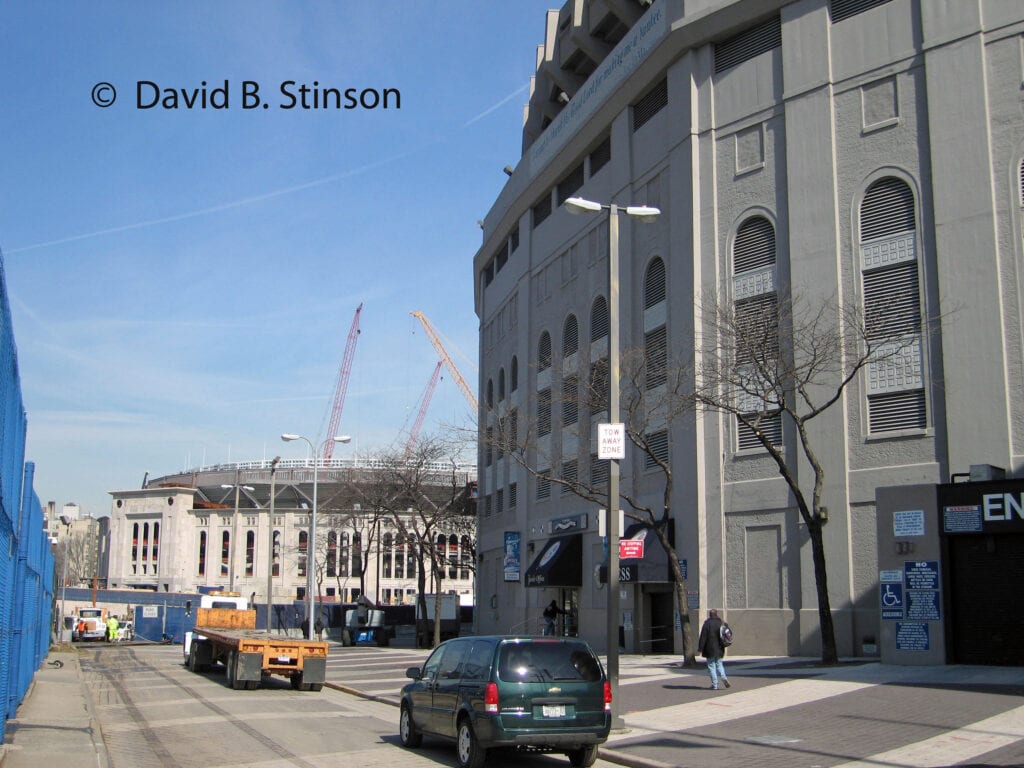

Change is a part of our history and our culture. The now-unknown amateur photographers who captured these images helped document that cultural and historical change. Their desire to capture the moment on a Circle Line cruise decades ago, allows us to see, and for some, to relive, two iconic ballparks and what is an ever-changing landscape.
NOTE AS TO THE PHOTOGRAPHS: I own the original slides and snapshots that appear in this blog, and I created the digital images of the photographs (marked deadballbaseball.com). I do not own the copyright to any photographs, with the exception of the two photographs that appear at the end of this blog.

